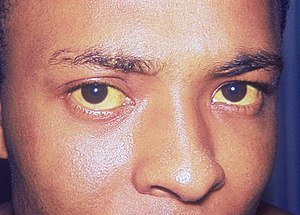Hepatovirus
| Hepatitis A | |
|---|---|
 |
|
| A case of jaundice caused by hepatitis A | |
| Classification and external resources | |
| Specialty | Infectious disease, gastroenterology |
| ICD-10 | B15 |
| ICD-9-CM | 070.0, 070.1 |
| DiseasesDB | 5757 |
| MedlinePlus | 000278 |
| eMedicine | med/991 ped/977 |
| Patient UK | Hepatitis A |
| MeSH | D006506 |
| Hepatitis A | |
|---|---|
 |
|
| Electron micrograph of hepatitis A virions | |
| Virus classification | |
| Group: | Group IV ((+)ssRNA) |
| Order: | Picornavirales |
| Family: | Picornaviridae |
| Genus: | Hepatovirus |
| Species: | Hepatovirus A |
| Synonyms | |
|
|
Hepatitis A (formerly known as infectious hepatitis) is an infectious disease of the liver caused by the hepatitis A virus (HAV). Many cases have few or no symptoms, especially in the young. The time between infection and symptoms, in those who develop them, is between two and six weeks. When symptoms occur, they typically last eight weeks and may include nausea, vomiting, diarrhea, jaundice, fever, and abdominal pain. Around 10–15% of people experience a recurrence of symptoms during the six months after the initial infection.Acute liver failure may rarely occur, with this being more common in the elderly.
It is usually spread by eating food or drinking water contaminated with infected feces.Shellfish which have not been sufficiently cooked are a relatively common source. It may also be spread through close contact with an infectious person. While children often do not have symptoms when infected, they are still able to infect others. After a single infection, a person is immune for the rest of his or her life. Diagnosis requires blood testing, as the symptoms are similar to those of a number of other diseases. It is one of five known hepatitis viruses: A, B, C, D, and E.
The hepatitis A vaccine is effective for prevention. Some countries recommend it routinely for children and those at higher risk who have not previously been vaccinated. It appears to be effective for life. Other preventive measures include hand washing and properly cooking food. No specific treatment is available, with rest and medications for nausea or diarrhea recommended on an as-needed basis. Infections usually resolve completely and without ongoing liver disease. Treatment of acute liver failure, if it occurs, is with liver transplantation.
Globally, around 1.4 million symptomatic cases occur each year and about 102 million infections (symptomatic and asymptomatic). It is more common in regions of the world with poor sanitation and not enough safe water. In the developing world about 90% of children have been infected by age 10 and thus are immune by adulthood. It often occurs in outbreaks in moderately developed countries where children are not exposed when young and vaccination is not widespread. Acute hepatitis A resulted in 102,000 deaths in 2010.World Hepatitis Day occurs each year on July 28 to bring awareness to viral hepatitis.
...
Wikipedia
